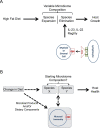Linking the microbiota and metabolic disease with lymphotoxin
- PMID: 23657002
- PMCID: PMC4719164
- DOI: 10.1093/intimm/dxt018
Linking the microbiota and metabolic disease with lymphotoxin
Abstract
The field of lymphotoxin biology has seen many advances in the past decade. Notably, a role for lymphotoxin as a key effector cytokine has emerged to add to its foundational contribution to lymphoid organogenesis. It is now clear that lymphotoxin contributes to host defense for a wide variety of pathogens, and the lymphotoxin receptor is a defining feature of and regulatory mechanism in both innate and adaptive immunities. Specifically, lymphotoxin contributes to Th education, licensing of IL-22 production from type 3 innate lymphoid cells, and even maintains innate myeloid populations within the fully developed lymph node. Most recently, lymphotoxin has been implicated in regulation of the microbiota and metabolic disease. Early studies revealed that lymphotoxin might influence composition of the commensal microbiota through its regulation of immunological compartmentalization in the gut. Additionally, several epidemiological studies have linked polymorphisms in lymphotoxin to metabolic disease. Studies exploring the role of lymphotoxin in metabolic disease have demonstrated that lymphotoxin may influence metabolism both directly in the liver and indirectly through regulation of gut immune responses. It now appears that lymphotoxin may bridge the gap between altered composition of the commensal microbiota and metabolism.
Keywords: SFB; diabetes; lymphotoxin; metabolism; microbiota; obesity.
Figures

Similar articles
-
Lymphotoxin organizes contributions to host defense and metabolic illness from innate lymphoid cells.Cytokine Growth Factor Rev. 2014 Apr;25(2):227-33. doi: 10.1016/j.cytogfr.2013.12.007. Epub 2013 Dec 24. Cytokine Growth Factor Rev. 2014. PMID: 24411493 Free PMC article. Review.
-
Nonredundant function of soluble LTα3 produced by innate lymphoid cells in intestinal homeostasis.Science. 2013 Dec 6;342(6163):1243-6. doi: 10.1126/science.1243364. Science. 2013. PMID: 24311691
-
Lymphotoxin signalling in immune homeostasis and the control of microorganisms.Nat Rev Immunol. 2013 Apr;13(4):270-9. doi: 10.1038/nri3406. Nat Rev Immunol. 2013. PMID: 23524463 Free PMC article. Review.
-
Gut microbiota drives metabolic disease in immunologically altered mice.Adv Immunol. 2012;116:93-112. doi: 10.1016/B978-0-12-394300-2.00003-X. Adv Immunol. 2012. PMID: 23063074 Review.
-
The role of the gut microbiota in energy metabolism and metabolic disease.Curr Pharm Des. 2009;15(13):1546-58. doi: 10.2174/138161209788168164. Curr Pharm Des. 2009. PMID: 19442172 Review.
Cited by
-
Lymphotoxin organizes contributions to host defense and metabolic illness from innate lymphoid cells.Cytokine Growth Factor Rev. 2014 Apr;25(2):227-33. doi: 10.1016/j.cytogfr.2013.12.007. Epub 2013 Dec 24. Cytokine Growth Factor Rev. 2014. PMID: 24411493 Free PMC article. Review.
-
Inflammatory pathway genes associated with inter-individual variability in the trajectories of morning and evening fatigue in patients receiving chemotherapy.Cytokine. 2017 Mar;91:187-210. doi: 10.1016/j.cyto.2016.12.023. Epub 2017 Jan 19. Cytokine. 2017. PMID: 28110208 Free PMC article.
References
-
- Chroboczek Kelker H., Oppenheim J. D., Stone-Wolff D, et al. 1985. Characterization of human tumor necrosis factor produced by peripheral blood monocytes and its separation from lymphotoxin. Int. J. Cancer. 36:69. - PubMed
-
- Ruddle N. H. 1992. Tumor necrosis factor (TNF-alpha) and lymphotoxin (TNF-beta). Curr. Opin. Immunol. 4:327. - PubMed
-
- Fu Y. X., Chaplin D. D. 1999. Development and maturation of secondary lymphoid tissues. Annu. Rev. Immunol. 17:399. - PubMed
-
- Lo J. C., Wang Y., Tumanov A. V, et al. 2007. Lymphotoxin beta receptor-dependent control of lipid homeostasis. Science. 316:285. - PubMed
Publication types
MeSH terms
Substances
Grants and funding
LinkOut - more resources
Full Text Sources
Other Literature Sources
Medical
Miscellaneous

